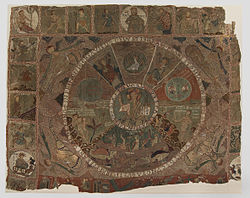Bayeux Tapestry
The Bayeux Tapestry is a 0.5-by-68.38-metre (1.6 by 224.3 ft) long embroidered cloth – not an actual tapestry – which depicts the events leading up to the Norman conquest of England as well as the events of the invasion itself. The tapestry is annotated in Latin. It is exhibited in a special museum in Bayeux, Normandy called Musée de la Tapisserie de Bayeux.
The tapestry tells the story of the Norman conquest of England. The two combatants are the Anglo-Saxon English, led by Harold Godwinson, recently crowned as King of England, and the Normans, led by William the Conqueror.
The tapestry is regarded as one of the greatest examples of Anglo-Saxon art, because, though ordered by a Norman, it was made by English (Anglo-Saxon) artisans. It is also extremely important as a historical document.
In common with other embroidered hangings of the early medieval period, this piece is conventionally referred to as a "tapestry", although it is not a true tapestry in which the design is woven into the cloth; it is in fact an embroidery.
The Bayeux tapestry is embroidered in wool yarn on a tabby-woven linen ground using two methods of stitching: outline or stem stitch for lettering and the outlines of figures, and couching or laid work for filling in figures.[1][2] The linen is assembled in panels and has been patched in numerous places.
The main yarn colours are terracotta or russet, blue-green, dull gold, olive green, and blue, with small amounts of dark blue or black and sage green.
Bayeux Tapestry Media
A scene from the Bayeux Tapestry depicting Bishop Odo rallying Duke William's army during the Battle of Hastings in 1066
Bishop Odo of Bayeux
Montfaucon / Benoît drawing showing King Harold's death
Edward the Confessor sends Harold to Normandy
The Tapestry of Creation or Girona Tapestry (actually needlework), 11th-century, 3.65 m × 4.70 m (12.0 ft × 15.4 ft)
The messengers with Guy I, Count of Ponthieu, with a portrayal of medieval agriculture in the border
Detail of Halley's Comet
References
- ↑ Wilson, David McKenzie (ed) 2004. The Bayeux Tapestry : the complete tapestry in color, rev. ed. New York: Thames & Hudson. ISBN 0-500-25122-3
- ↑ Coatsworth, Elizabeth 2005. "Stitches in time: establishing a history of Anglo-Saxon embroidery", in Robin Netherton and Gale R. Owen-Crocker, editors, Medieval clothing and textiles, Volume 1, Woodbridge, 1-27.










